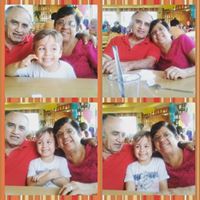Juan M Angulo
age ~74
from Sparta, MI
- Also known as:
-
- Juan Munoz Angulo
- Juan M Angllo
- Juan Munoz
- Phone and address:
-
10025 Division St, Sparta, MI 49345
6168877613
Juan Angulo Phones & Addresses
- 10025 Division St, Sparta, MI 49345 • 6168877613
- 10025 N Division Ave, Sparta, MI 49345 • 6165813991
- Primera, TX
- 15311 Peach Ridge Ave, Kent City, MI 49330 • 6166755219
Work
-
Position:Clerical/White Collar
Education
-
Degree:Associate degree or higher
Us Patents
-
Electrical Box With Dual-Hinged Cover
view source -
US Patent:20190222009, Jul 18, 2019
-
Filed:Jan 17, 2019
-
Appl. No.:16/250086
-
Inventors:Norman R. Byrne - Ada MI, US
Joel T. Ruiter - Ada MI, US
Peter Bergendahl - South Burlington VT, US
Joseph D. Ward - Grand Rapids MI, US
Juan Carlos Angulo - Grand Rapids MI, US -
International Classification:H02G 3/08
H02G 3/14 -
Abstract:An electrical box supports one or more electrical or electronic data outlets in a cavity, with a dual-hinged door at least partially covering an opening to the cavity when the door is closed. The door is openable in either of two directions by pivoting it about either of two spaced-apart pivot axes that are defined by respective pivot arms coupled to opposite ends and opposite sides of the door, the pivot arms being further coupled at their respective proximal ends to opposite walls of the housing. A retaining feature releasably secures the door in the closed position and may provide sensory feedback to a user upon closing the door. Optionally, the door has a floating appearance in the opening to the cavity, with no direct contact existing between the door and the housing.
-
Electrical Power Or Data Distribution System
view source -
US Patent:20190148850, May 16, 2019
-
Filed:Nov 15, 2018
-
Appl. No.:16/191517
-
Inventors:Norman R. Byrne - Ada MI, US
Timothy J. Warwick - Sparta MI, US
Aaron G. Lautenbach - Rockford MI, US
Jonathan M. Golub - Rockford MI, US
Juan Carlos Angulo - Grand Rapids MI, US -
International Classification:H01R 9/24
H01R 12/61
G06F 13/38
H01R 12/77 -
Abstract:An electrical power or electronic data distribution system includes a power supply or electronic data module that receives electrical power or electronic data signals from a source, a flat-conductor strip for routing electrical power or electronic data along a generally planar surface such as a floor, wall, room divider, or ceiling, and a power or data output block. The power supply has a pair of power outfeed conductors, and the flat-conductor strip has a pair of generally planar electrical conductors in spaced arrangement, which are electrically coupled to respective power outfeed conductors. The output block has a pair of power-receiving contacts along a lower surface thereof, and an electrical receptacle at the output block, the receptacle being positioned above the lower surface. The power-receiving contacts electrically engage respective planar electrical conductors and convey electrical power to respective contacts of the electrical receptacle, for powering electrical or electronic devices.
Wikipedia References

Juan Camilo Angulo
License Records
Juan Carlos Angulo Revollo
License #:
2705148773
Category:
Contractor
Juan E Angulo
License #:
31567 - Active
Category:
Tow Truck Operator (Consent Tow)
Expiration Date:
Jul 20, 2017
Classmates

Juan Angulo
view sourceSchools:
Northeast Lauderdale High School Meridian MS 1983-1987
Community:
Matt Jumper

Juan Angulo (Campos)
view sourceSchools:
Los Angeles Community Adult School Los Angeles CA 1995-1998
Community:
Delmy Reyes

Juan Angulo
view sourceSchools:
Levittown High School Toa Baja NJ 1990-1994
Community:
Rolando Rosario, Elliott Gomez, Ruth Gonzalez

Juan Angulo
view sourceSchools:
University Gardens Escuelas Rio Piedras NJ 1977-1981
Community:
Emilia Linda, Juan Sola, Myrna Hernandez, Zupi Zubizarreta

Juan Angulo
view sourceSchools:
Greenglade Elementary School Miami FL 1981-1984
Community:
Lori Hutto, Marilyn Ramos, Kate Windisch, Debra Caldwell, Tina Odom

Juan Carlos Angulo
view sourceSchools:
Johnson High School Barranquilla Colombia 1985-1994
Community:
Richard Capps

Juan Angulo
view sourceSchools:
Nogales High School West Covina CA 1990-1994

Juan Angulo, Taft High Sc...
view sourceYoutube
Flickr
Plaxo

JUAN ANGULO
view sourceGerente de Ventas at T News

Juan Enrique Angulo
view source
Juan Carlos Angulo
view source
Juan Manuel Angulo
view source
Juan Carlos Angulo
view source
Juan Angulo Cascante
view source
Juan Angulo
view source
Juan Angulo Guzman
view source
Juan Angulo
view sourceMyspace
Googleplus

Juan Angulo
Work:
Parker Hannifin (2010)
Education:
University of Texas at Arlington - Mechanical engineering

Juan Angulo
Education:
Facultad de Ingenieria
Bragging Rights:
INGENIERIA UNAM

Juan Angulo

Juan Angulo

Juan Angulo
Tagline:
Day Without Music = Wasted Day

Juan Angulo

Juan Angulo

Juan Angulo
Get Report for Juan M Angulo from Sparta, MI, age ~74

![Juan David Angulo[ Nuevo Refuerzo Azulgrana] Juan David Angulo[ Nuevo Refuerzo Azulgrana]](https://i.ytimg.com/vi/gtY3KMujjR8/hq720.jpg?sqp=-oaymwEcCNAFEJQDSFXyq4qpAw4IARUAAIhCGAFwAcABBg==&rs=AOn4CLBxZ9hLcRajPiFcFE9CZ970RvD7jQ)
















